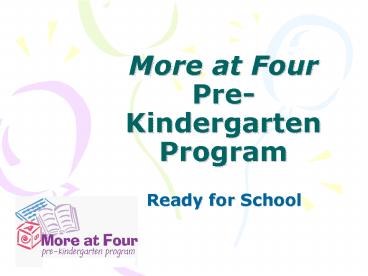More at Four PreKindergarten Program - PowerPoint PPT Presentation
1 / 24
Title:
More at Four PreKindergarten Program
Description:
Estimated 1-3 star centers -13,198. Total Estimated Unserved 10,687. More at Four Legislation ... child care centers. More for-profit centers than non-profits ... – PowerPoint PPT presentation
Number of Views:46
Avg rating:3.0/5.0
Title: More at Four PreKindergarten Program
1
More at Four Pre-Kindergarten Program
- Ready for School
2
More at Four Purpose/GoalsGovernor Easleys
Vision
- Readiness for Kindergarten (closing the gap)
- Focus on at-risk children
- Developmentally appropriate educational program
- Voluntary
- Build on existing service delivery system
3
Estimated Unserved/Underserved
- 4 year olds 110,862
- at-risk 4 year olds
- (FRL) 44,345
- 4/5 y.o. preschool
- disabilities (not in other) 5,342
- Total At-Risk 49,678
- Currently served
- (Title I, 4/5-star, Head Start) -25,802
- Total Unserved Underserved 23,876
- Estimated 1-3 star centers -13,198
- Total Estimated Unserved 10,687
4
More at Four Legislation
- 6.456 million 2001-02 (1621 slots)
- 28 million expansion 2002-03 (to 7621 slots)
- 8.6 million expansion 2003-04 (to 10,000 slots)
- Requirement for Local Contribution
- Joint DHHS and DPI initiative
- More at Four Task Force Oversight
5
More at Four Legislation - continued
- Essential program requirements
- External Evaluation (no longer in legislation as
of 03-04) - Child-Specific Database with ability to link to
public school database - Study of all funding sources going to four-year
olds recommendations for any changes
6
Program Requirements in Brief
- Maximum class size 18 91 ratio
- 6 to 6 ½ hour school day
- Specific criteria for at-risk children
- Five domains of development addressed Required
research-based curriculum - Staff qualifications established
- Facility/environment requirements
- Family involvement
- Screening ongoing assessments required
7
Domains of Development
- Health and physical development
- Social/emotional development
- Approaches to learning
- Language development/communication
- Cognition general knowledge
8
At-Risk Criteria 2002-03 2003-04 Optional
- Family Income
- Childs Health Status
- Identified Special Needs
- Parent Education
- Parent Employment
- Family Composition
- Housing Stability
- English Proficiency
- Minority Status (in combination w/ others)
9
At-Risk Criteria 2003-04 Optional Required
2004-05
- 130 below of poverty 5 pts.
- 131-185 of poverty 4 pts.
- 186-200 of poverty 3 pts.
- 201-250 of poverty 2 pts.
- Extra weighted factors
- Limited English proficiency 1 pt.
- Identified disability 1 pt.
- Chronic health problem 1 pt.
10
At-risk Criteria 2004-05 (continued)
- For children 251-300 poverty level, can be
eligible for following reasons - Limited English proficiency
- Identified disability
- Chronic health problem
- Development/educational need
- No more than 20 of a countys slots may be
filled in this manner.
11
Order of Priority for Service
- Unserved Children (never or currently unserved)
- Eligible for subsidy but not receiving it
- Unregulated care
- Other children meeting at-risk criteria,
including those in programs not meeting More at
Four standards
12
Recommended Curricula
- High Scope
- Creative Curriculum
- Bright Beginnings
- Montesorri
- Bank Street College
- Note
- Other curricula may be reviewed
- Other materials may be used in combination with a
comprehensive curricula
13
Staff Qualifications Minimum Credentials
- Lead teachers - B-K license or pre-school add-on
(4 years to attain) - Assistants - CDA credential two-year ECE/CD
degree strongly encouraged - Administrators - schools principal license
degree in ECE/CD a goal - Administrators other pre-K settings Level II
working toward Level III - Salaries and benefits comparable to public
schools
14
Implementation Process
- State Collaboration DHHS, DPI, NCPC, Governors
Office - State develops standards/guidelines
- Community Collaboration all relevant early
childhood groups - Develop Local Plan for Use of Slots and
Leveraging of Resources-Designates Administrator - Orientation Curriculum Training by State More
at Four Office
15
Putting the Pieces Together
16
How do they all fit?
Smart Start
Not This Neatly, But it Works
17
Organizational ManagementStructure
NCPC/ Smart Start
More at Four State- Wide Task Force
DHHS, Secretarys Office (budget/contracts)
Chair
Chair
Dept. of Public Instruction
(Executive Committee)
More at Four Pre-K Office (Governors Office)
County Planning Comm Chairs, Supt. Smart
Start Bd. Chair
County Administering Agency
Sites Public Schools
Sites Private Child Care
Sites Head Start
18
Implementation Status 2001-02
- 165 classes 1621 child positions approved
- 28 grants 34 counties
- 55 classrooms in public schools
19
Implementation Status 2002-03
- Expansion to 7,621 positions
- Moved to formula allocation process for all
counties - 91 of 100 counties under contract
- Slower implementation than desired due to late
budget, budget cuts, space issues qualified
staff - Over 6400 children served
20
Implementation Status 2003-04
- 99 Counties under contract last county
considering participation - 9,661 child slots under contract as of November
30th continuing to complete all 10,000 - 8550 children served to date
21
More at Four Children by Facility Type 2002-03
22
More at Four Children by Facility Type 2003-04
23
Comparisons from 2002-03 to 2003-04
- Slight decrease in number of slots in public
schools - Increase in private child care centers
- More for-profit centers than non-profits
- Decrease in Head Start slots (although may
increase)
24
More at Four Web Page
www.governor.state.nc.us (Look for the
rectangular link)
919 715-0040
Carolyn.cobb_at_ncmail.net































